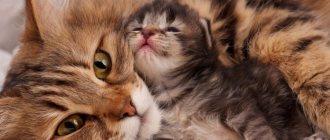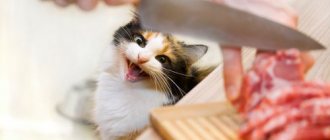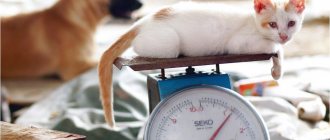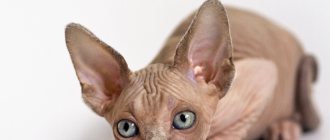Many owners of these cute animals face the problem of how to feed a kitten without a cat. The fact is that sometimes situations arise when a mother cat dies or, for some reason, refuses to feed her kittens. In this case, the mother for them should be the owner of the animal, who will have to feed it on his own. If he has information on how to feed a small kitten without a cat, he can easily cope with this task.
Many owners of these cute animals face the problem of how to feed a kitten without a cat.
How to feed a newborn kitten
The first question a person asks in such a situation is how can one feed a newborn and what can be given?
Of course, if it is possible to place a kitten on a cat that feeds kittens so that she can take it for food, that would be ideal.
You should make sure that the nursing mother is healthy and cannot infect the kitten with infectious diseases and parasites.
Most often, lactating cats accept other people's kittens and feed them along with their own offspring. But finding a wet nurse can be difficult, so you should look for another way out of the situation. A person is quite capable of coping with the process of caring for a newborn kitten, choosing special feeding products and creating a diet.
The process of feeding the baby will take several weeks and will be quite labor-intensive until the kitten learns to eat on its own.
Feeding is, of course, the most important process in caring for a newborn. But, besides this, the kitten also needs other care. The cat warms its kittens by constantly being nearby (especially in the first time after birth), licking and caressing them.
Therefore, a person must provide the kitten with cleanliness, warmth and affection. Children, even blind and helpless ones, are aware of how they are treated. Kittens calm down if they are fed and warm.
What else is needed to feed kittens?
After you have learned how to feed a kitten without a cat, it is also worth getting an idea about caring for it during the feeding period. So, for this you need to perform the following manipulations:
- make a heated nest for your charges;
- ensure hygiene in it;
- ensure the removal of waste directly from animals.
The temperature of the nest for a kitten should correspond to 38 °C.
As for the nest, its temperature should correspond to the average temperature of a cat - 38 °C. The thing is that the first 2 weeks of life require creating an increased temperature for kittens, which is generated by a cat under normal conditions. In order to achieve this effect artificially, it will be necessary to make a nest for them from baby diapers or fabric. To maintain the optimal temperature in it, you need to put an electric heating pad, a hot water bottle or a regular heating pad in it.
It is best to wrap the heating pads and bottle in a rag or towel. As for hygiene, it is worth periodically making a new nest and throwing away the old one. To prevent waste from spreading across the floor, it is necessary to place the nest in a basin; it is best not to use a paper box for this purpose.
Nursing kittens should be protected from drafts
Hygienic procedures must also be taken for the animals themselves. The fact is that in nature, kittens are cleaned by the mother cat. With artificial feeding, for obvious reasons, a person must take over its functions. This can be done using a special cloth glove. Until the animals grow up, it is better not to bathe them.
Important! Breastfeeding kittens must be protected from drafts, so when cleaning the nest they must be placed in a warm place, sheltered from the wind.
In addition, be sure to give your babies something to drink, unless, of course, there is a large amount of moisture in the nutritional mixture. Only by performing all procedures carefully and on time, you will be able to raise healthy and beautiful kittens, which over time will become your pets.
What can you feed newborn kittens?
What can you feed newborn kittens? Of course, milk immediately comes to mind. And this is where the main mistake lies.
Cow's milk should not be used to feed a newborn furry baby. The protein of such milk is practically not absorbed by the animal’s small body; cow’s milk can form lumps in the pet’s stomach.
It is undesirable to use goat's milk in the diet. Its fat content exceeds what is acceptable for a small organism. Because of this, the animal may experience severe digestive problems, and in some cases, the kitten may even die.
It is best to feed babies with a formula designed specifically for newborn kittens. Such products are sold through veterinary stores. The composition of this food closely matches the composition of cat's milk, so it will provide the kitten with all the substances necessary for growth and development.
If you suddenly couldn’t find a similar formula for kittens (and in small towns it’s really difficult to get it), buy baby food for newborns, it’s better than regular milk.
The body temperature of cats is 38 degrees, the mixture that you are going to feed the kitten should be heated to about 36.
The nutritional mixture should be prepared immediately before you are going to feed the kitten. Mixture dissolved a few hours ago should not be given to kittens.
Why does a cat abandon kittens?
Despite the fact that pets are considered caring and attentive, due to a number of factors the natural mechanism of maternal care can fail. There may be several reasons why a cat refuses kittens:
| Cause | Justification for the action |
| Young age of the animal, first birth | An inexperienced mother does not immediately demonstrate the instincts of motherhood inherent in nature. As a rule, on the second day after birth, the animal accepts the kittens and takes proper care of them. |
| Postpartum complications | Diseases such as mastitis (inflammation of the mammary glands), endometritis (inflammation of the lining of the uterus) and simply difficult childbirth are accompanied by pain, physical and psychological stress. With postpartum eclampsia (severe lack of calcium in the body), a disorder occurs in the cat’s nervous system (postpartum insanity), and she abandons the babies |
| Stressful situation | Excessive attention to the animal during childbirth, interference in the intimate process can cause severe stress in the cat, against the background of which it abandons its offspring |
| Foreign odors from kittens | A cat may abandon her babies if they don't smell like her. This often happens if household members hold babies in their arms, and they stop smelling like their mother. This behavior is especially dangerous towards newborns who have not yet smelled their mother cat. |
| Lack of milk in the first days after birth | The reason why a cat abandons newborn kittens may be the lack of lactation due to hormonal imbalance immediately after lambing. |
| Non-viability of babies | The cat instinctively identifies the sick cub and abandons it, giving others a chance to survive. The same fate awaits a hypothermic kitten (with a low body temperature), which is also an indicator of non-viability for the mother |
| Weak maternal instinct | Most often this happens to spoiled pets who do not bother themselves with caring for their offspring, completely shifting the entire burden of this process onto the owner |
How to feed a newborn kitten?
Many “adoptive parents” have a question: how to feed a small kitten without a cat, since he doesn’t know how to lap? Feeding should be done from a special bottle designed for newborn kittens, which can be purchased at a pet store, from a pipette, a small medical bulb, or a syringe without a needle.
There is no difference in what to feed the kitten from. What is more important is what to feed and when.
Before feeding, dishes should be thoroughly washed and boiled. By using a sterile pacifier or bottle, you do not expose your kitten to possible infection with microorganisms and pathogenic bacteria. Remember! The immune system of such babies is not yet developed! Make it a rule to wash dishes immediately after feeding and sterilize them once a day. It is enough to boil everything you use to care for your kitten for 10 minutes.
Maintain personal hygiene when caring for your pet. Always wash your hands thoroughly before preparing formula and feeding your pet. Try to use fragrance-free soap at this time so that the baby does not inhale unnecessary aromas.
While feeding, the kitten should be picked up, placed on its tummy and its head raised. Place a pacifier or pipette in your mouth. If the cat eats this way for the first time, stroke his head and back, push the nipple slightly to feel it.
If you use a syringe for feeding, be careful not to damage the animal's nose and mouth, as the syringe has a hard surface and corners. If you are afraid to do this, take a pacifier or a pear; they will be easy for the kitten to grab and will definitely not hurt him.
To avoid injury and choking, do not push the tip of the pacifier deep into the mouth. The cat will grab it and determine the depth itself when it starts to suck. Be careful while feeding, make sure that the baby does not choke.
Please note that a newborn kitten should be fed in small portions both day and night at intervals of two hours. This diet should be followed for the first two weeks of life.
Next, a 3-4 week old kitten should be fed every 3 hours, and 4 week old kittens should be fed at intervals of once every 5-6 hours. Night feedings are mandatory for small kittens; if they are canceled, the animals will quickly weaken, lose weight and stop developing properly.
Therefore, owners who receive kittens without a cat should be patient and endure the first month of their life. A baby at this age cannot do anything on his own, and if he is abandoned and not cared for, he will not survive.
How to prevent it?
During pregnancy, prepare your cat for lambing: - monitor her weight;
— feed properly (calcium and vitamins are required); - communicate and reassure; - prepare a soft place for birth and offer it to the cat. The pet itself should lie down in the nest and feel comfortable in it even at the stage of pregnancy. During the birth, be present and have the veterinarian's number handy, as well as all necessary medications and tools. After lambing, do not handle the kittens so as not to disturb the mother’s scent. Keep children and pets away from a lambing cat.
What to feed a small kitten and how to calculate portions?
We described above what to feed a small kitten, but now we’ll tell you how to calculate the portion for one feeding. The serving size of the nutritional mixture depends on the weight of the cat.
The baby should receive the following doses of food for every 100 grams of weight:
- first week of life – 30 ml,
- second week of life – 35 ml,
- third week of life – 40 ml,
- fourth week of life and older – 50-55 ml.
See also: How to make two cats friends?
This is the volume of mixture that a small kitten should receive during the day. Therefore, it is important to divide this small amount into several equal doses and give it to the baby without overfeeding him.
How to understand that the cat is full? If the newborn is full, he lets go of the pacifier or bottle and falls asleep. If he is still hungry, he will poke and squeak in search of a bottle.
If the kitten refuses to eat and becomes weaker, take it to the veterinarian; there may be some kind of disease. A healthy newborn pet will not refuse food.
After you have fed the kitten, place it tummy up and stroke it for a while without pressing. Sometimes your pet may begin to burp; this is quite normal, since the body is still small and reacts in this way to incoming food.
Then the baby should be placed in a bed or box, covered, a hot bottle placed under his side (mom simulator, ~40 degrees, more on that below) and allowed to sleep.
After four weeks, the kitten begins to eat on its own. You can gently poke his nose into the mixture so that it gets on his face. The cat will lick the mixture from its face and then begin to lap from the bowl.
From the time your baby begins to feed on his own, introduce other foods into his diet. It is recommended to start with meat infant formula, replace one meal with it, then alternate equally.
At the age of two months, the kitten can be switched from formula to kitten food. Pet stores offer a wide selection of food at different prices.
See also: Cat grooming: how to give your pet a haircut at home
Self-feeding kitten
At the age of three weeks, you can begin to introduce complementary foods into the kittens' diet. To avoid causing digestive disorders, portions should be very small, about the size of a pea.
What can and cannot be fed to kittens?
Can:
- food of soft and delicate consistency for kittens, preferably in the form of mousse.
It is forbidden:
- raw meat and fish;
- fatty, salty and fried foods;
- chocolate and sweets;
- food from your table.
How often should you give your kitten food? After introducing complementary foods, the frequency of feedings can be gradually reduced. In any case, consult your veterinarian regarding nutrition and introduction of complementary foods.
Hygiene procedures
In addition to nutrition, you should know other rules for caring for a newborn kitten. After eating, you can massage your cat's tummy clockwise with your fingers or the area under the tail, using a cotton pad soaked in water to empty the intestines.
Cats lick their cubs and try to keep their mouths, eyes, ears, and excretory organs clean. Wipe and wash the cat with warm and damp wipes, dry it so that it does not freeze after the procedures. Wash completely once a day in warm water.
The kitten needs a place to sleep and play at first. To begin with, a deep box is suitable, in which you need to lay soft bedding.
Cover your cat's area with old diapers or cut-up sheets so they can be easily washed or thrown away.
Vitamins and supplements
From birth until weaning, kittens receive all beneficial substances from the cat through milk and colostrum. But since the animals are artificially fed, their diet must include vitamins and supplements. What complexes are best to give to kittens, be sure to ask your veterinarian.
For two-week-old kittens you can use:
- Glucose (1-2 g per feeding). Promotes weight gain and better satiety.
- Trivit, Tetravit. One drop per serving is enough.
- Gamavit. Immunostimulant. 1 drop per feeding.
- Meat and bone meal. Contains calcium, which is necessary to strengthen bones and teeth.
- Fish fat. Source of vitamin D. Give once every 7-8 days, one drop per feeding.
You can also use vitamins A, D, E, and preparations containing vitamin B (B1, B2, B6, B9, B12).
Note that many vitamin and mineral supplements and preparations are intended for two-month-old kittens and older animals. Therefore, do not overdo it with the dosage.
Keep in mind that industrial milk substitutes already contain minerals and vitamins. An excess, as well as a deficiency of nutrients, can cause health problems.
Hot water bottle for a newborn kitten
The cat warms its kittens, but in its absence, the baby should be provided with bottles of warm water, heating pads, and covered with terry cloth to keep them warm and soft. You can use a lamp that will warm the baby from above.
Ideally, the temperature of the place where the newborn kitten is kept should be equal to or slightly exceed 30 degrees. From the middle of the second week of life, the temperature of the kitten can be reduced, gradually bringing it to room temperature. During airing, the box with the kitten should be taken to another room.
Make sure that the box where the newborn kitten is located is always warm, dry and clean. Excess bacteria that appear when dirt appears can harm the baby's health.
Thus, we found out that a newborn kitten can be saved and fed even in the absence of a cat. It is important to provide your pet with food, cleanliness and care. Don’t forget to pick up the cat, talk to it, stroke it, and after a while you will definitely hear a grateful purr in response.
Milk substitutes and formulas
Milk substitutes and milk formulas for animals or infants are the best option for feeding kittens left without a cat. They can be purchased at a veterinary pharmacy, veterinary clinic or pet store.
Advice! Give preference to products from well-known brands and brands. If you find it difficult to choose, consult with your veterinarian regarding the choice of artificial nutrition for orphaned kittens.
A high-quality substitute has a composition that is almost similar to the milk of a lactating female. It contains proteins, carbohydrates, vitamins, amino acids, and other useful substances for the development of small kittens.
Feeding formulas can be used for both kittens and infants. If necessary, below are recipes that are used to feed artificial kittens.
Industrial cat milk substitutes
There is a large selection of cat milk replacers in powder and liquid. Experts and veterinarians recommend products from the following brands and brands for bottle-fed kittens:
- Babycat Milk (Royal Canin). For feeding kittens from birth to 2 months.
- Katzenmilch. For feeding from the first days.
- Hartz.
- Gimpet Cat-Milk.
- Nurturall-C.
- Dolfos Dolmilk Cat.
- Beaphar Kitty milk.
Before preparing the mixture, carefully read the instructions on the package. The manufacturer indicates the approximate daily dose and preparation methods.
Industrial cat milk replacers for 2-week-old kittens are also used for feeding babies if the cat does not have enough milk. They are also recommended to be given to weakened pets who are not gaining weight well and to pregnant cats.
Infant milk formulas for kittens
For artificial kittens at two weeks of age, infant formula for kittens is also used. They can be purchased at any pet store. If you don’t have formula on hand, you can buy milk nutrition for infants at any pharmacy ( Nutrilon, Malyuk ). But dry formulations for kittens are diluted with twice as much water as indicated on the package.
Features of feeding
In cases where, for a number of reasons, 2-week-old kittens are left without a mother, caring for them falls entirely on the shoulders of the owners. These babies are still completely defenseless and absolutely not adapted to independent life. As a rule, by 2 weeks, babies already open their eyes, their teeth begin to cut, and traces of the umbilical cord disappear. During this period, the main attention should be paid to feeding:
- Cow's milk is considered an acceptable product for complementary feeding, and it is important to use natural, whole, good quality products. The presence of lactose and fats in it can cause severe disorders in the functioning of the gastrointestinal tract and even lead to the death of the baby.
- Specialized mixtures and cat milk substitutes are also suitable for complementary feeding, which can be purchased at a pet store or prepared independently.
- In the first month of a kitten’s life, it is important to strictly adhere to the feeding regimen. Violation of the schedule and errors in nutrition cause serious damage to the health of children and cause the development of chronic ailments, disorders and systemic disorders in the future.
- It is important to feed babies exclusively fresh food that has not been in the refrigerator for more than a day. In this case, the temperature of complementary foods should be room temperature.
Amount of formula for one feeding
It’s not difficult to determine whether a kitten is getting enough. Hungry babies constantly squeak and crawl in search of their mother. If you present them with a finger, they immediately strive to suck it. Well-fed kittens are calm and... Having eaten, they go to bed.
There are also certain physiological factors that indicate both that the baby is overeating and that he is undernourished. We're talking about kitten poop :
- With slight overfeeding - liquid and yellow
- With moderate overfeeding - greenish
- With constant overfeeding - gray
Please note that you need to pay special attention to gray or white feces, as these colors of feces may indicate infectious diseases in the kitten.
If the kitten is malnourished, it sleeps little, trembles, squeaks and is lethargic. Besides that, kittens. Babies who receive too little food practically do not gain weight.
© shutterstock
Possible ways to feed kittens
At the age of 2 weeks, it is extremely important to pay special attention to the correct algorithm for feeding kittens:
- Place . The baby should be placed on his knees, with a disposable diaper or polyethylene placed under his abdomen, and his head should be slightly raised. Most owners note that the most convenient place for feeding is a small box with sides. The baby needs to be placed on the bottom of the box so that his front paws rest against the side, lift his head by the scruff of the neck and start eating.
- Inventory . For feeding you need to use pipettes, disposable syringes and bottles. In this way, nutrition will enter the baby’s body drop by drop, as evenly and safely as possible. If the kitten's sucking reflex is poorly developed, it is better to replace the bottle with a nipple with a syringe or pipette. Using a syringe requires taking a number of precautions. Firstly, it is best to equip the syringe with a rubber tip, which reduces the likelihood of traumatic injury. It is important to teach the kitten to lick the mixture from the syringe, since it is impossible to completely introduce it into the oral cavity of small pets due to increased trauma to the gums and mucous membranes of the oral cavity.
- Head position . It is important that when feeding, the kitten's head is in a straight position and its paws are down. It is advisable for the baby to suck the milk himself. Therefore, you need to try not to pour food into the kitten’s mouth.
- Feeding rules . You need to feed slowly, without haste or fuss, so that the kittens do not choke.
What care will be required
Newborn babies abandoned by a cat need not only nutrition, but also special care. First of all, it is necessary to ensure that the air temperature meets the standards. So, at first, a week-old kitten feels comfortable in a room where the air temperature is in the range of +29…+32 °C. Gradually the air temperature drops - by about 2-3 degrees. When the babies abandoned by the cat are one month old, they will already be accustomed to the normal temperature regime in the house.
It is not recommended to use a heat fan to heat the room, as the flow of hot air will not benefit newly born animals. Experienced “cat breeders” advise using an electric heating pad, which can be placed under the “nest,” or a convector.
It is also important to monitor the cleanliness of the cat’s “nest” and the hygiene of small kittens. Remember to thoroughly wash feeding bottles and change diapers used as bedding. Unsanitary conditions can lead to the development of dangerous diseases.
Source
Doctors' recommendations
Following a number of rules will help owners go out and feed little kittens:
- It is imperative to monitor kittens' weight gain - this is the main criterion for assessing their health and degree of development. Body weight depends on the breed, but on average a baby at 2 weeks should weigh about 250 g.
- It is necessary to feed and keep kittens warm. At low temperatures, metabolic processes slow down, which leads to developmental delays and even death of the crumbs.
- It is important that kittens consume enough food. Special tables and consultation with a veterinarian will help you determine the dosage of complementary foods. If the baby does not eat well, then it is necessary to increase the frequency of feedings.
- After each meal, small kittens need a light massage, exposing the lower abdomen. This manipulation allows you to activate metabolism and improve food absorption processes.
- Before each feeding, owners should check their kittens' body temperature. You can do without a thermometer. Babies should just be warm to the touch. Otherwise, the kitten should be warmed up first and then offered food. This is due to the fact that at low body temperature, metabolism slows down and food absorption deteriorates. In addition, feeding babies with a body temperature below +35°C is fraught with the development of pneumonia and even death.
- Milk mixtures should be warm, but it is important to avoid overheating. The ideal option would be to heat the product in a water bath.
Take care of your kitten's hygiene
When a kitten has a mother, she licks him regularly. This way the kitten stays clean and learns to take care of itself. If there is no mother, this task falls on your shoulders.
You need to clean your kitten's fur after every feeding. It is enough to simply wipe the baby with a slightly damp soft cloth with short lint (this cloth resembles a mother’s rough tongue). If the kitten is very dirty, you can wash it in warm water. After washing, be sure to dry and warm the kitten.
Check your ears regularly. If they become dirty, they can be cleaned with a cotton pad or cotton swab.
At the age of eight weeks, the kitten can be given to a permanent home. At this age, babies already eat and drink on their own, go to the litter box, have been examined by a veterinarian and have had their first vaccinations. Kittens that have been raised by humans may require more attention and care from the owner. This should be taken into account when you are choosing a new home for your kitten.
Now you know how to feed a kitten and take care of its health. We wish you good luck and are sure that everything will work out for you!











